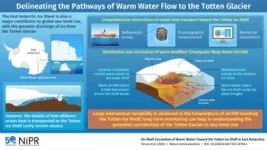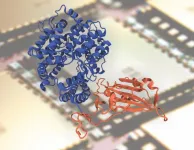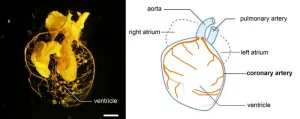(Press-News.org) PULLMAN, Wash. — A shipping container that can test passive cooling systems could help researchers and builders find carbon-free ways to keep people cool in extreme temperatures.
Washington State University researchers created the 60 square-foot chamber to test passive systems that use wind towers along with water evaporation instead of electricity to cool spaces.
Finding cooling methods that don’t require putting more greenhouse gases into the air is crucial to helping a growing population adapt to climate change, said Omar Al-Hassawi lead author of the study in the journal, Energies.
“Cooling is increasingly in demand in buildings, especially as the climate gets hotter,” said Al-Hassawi, assistant professor in WSU’s School of Design and Construction. “There might be inclusion of mechanical systems, but how can we cool buildings to begin with — before relying on the mechanical systems?”
The test chamber the researchers developed is solar powered with battery storage and is completely independent of grid power. It can be heated to a temperature range between 125 and 130 degrees Fahrenheit year-round to test cooling innovations, measuring the temperature, humidity and air velocity within and around a cooling system. The researchers calibrated the chamber using the results of a full-scale experiment that was conducted on a passive, downdraft cooling system tested under the hot dry conditions of Phoenix, Arizona.
“We can simulate extreme conditions,” Al-Hassawi said. “With smaller scale models, we can also do much quicker tests and get results sooner than having to wait on large-scale prototype construction.”
Buildings consume about 60% of the world’s electricity with nearly 20% of that going to keep them cool, according to Al-Hassawi. In the U.S., almost 90% of residential homes and apartments use mechanical air conditioners.
As people worldwide grapple with global warming, energy demand for mechanical air conditioning is expected to double by the year 2050. Powering air conditioning units requires electricity, which is often generated by fossil fuels, increasing carbon emissions and contributing to worsening global warming.
“There’s a lot of new construction with the rising global population that is going to happen in the coming years, and a lot of it is going to be in the developing world,” Al-Hassawi said. “So if we build like we’ve been building and continue to rely on mechanical systems to meet cooling demands, that’s going to be an issue. There’s going to be a lot more air conditioning that’s needed, especially with the population rise in the hotter regions of the world.”
Passive cooling systems that don’t require electricity have been used for centuries by people in hot places, going back to about 2500 BC in ancient Egypt. One cooling strategy involves capturing breezes from a tower. With a layer of moisture at the top of the tower, evaporation cools the air, which then becomes heavier and sinks by gravity into a living space below. The moisture can be provided by wetted pads, shower heads, or misting nozzles. Typically, mechanical fans are only required as a backup.
Although such systems are occasionally used in hot places like Phoenix, Arizona, people and building professionals are often not familiar with passive cooling techniques or misunderstand them. A passive cooling strategy could make use of old smokestacks in older buildings, for instance, as a cooling tower and could be applicable both for existing or new construction, said Al-Hassawi.
“It’s an older technology, but there’s been an attempt to innovate and use a mix of new and existing technologies to improve performance and the cooling capacity of these systems,” he said.
Wider adoption of such passive cooling systems could lower energy demand, but trying to research and test passive cooling systems takes considerable investment and training.
“That’s why research like this would really help,” he said. “How can we address building design, revive some of these more ancient strategies, and include them in contemporary building construction? The test chamber becomes a platform to do this.”
Students have designed and built some prototype cooling systems which utilize the passive downdraft cooling system. These will be tested starting next semester. Al-Hassawi hopes that industry partners might also be interested in testing passive system designs in the chamber over the coming academic year.
END
New test chamber created to find better ways to keep people cool
2023-08-22
ELSE PRESS RELEASES FROM THIS DATE:
Delineating the pathways of warm water towards East Antarctica’s Totten Glacier
2023-08-22
One of the most feared effects of global warming is the rise in sea level caused by the melting of polar continental ice. In fact, polar researchers have been working towards raising the awareness of this impending threat. The scientific fraternity relies on sampling the remote regions of Artic and the Antarctic continental shelves to estimate these risks. They can then use these measurements to model and understand the processes that drive the melting of ice at these locations and determine the extent of meltwater that will eventually flow ...
Hundreds of Andean bird species at risk due to deforestation: New research shows how to protect them
2023-08-22
Birds native to the tropical Andes, many of which cannot be found anywhere else, are threatened by increasing agricultural development in the region. A new study details how the resulting habitat loss affects specific species and lays out possible ways to protect birds from human-driven disturbance.
The researchers combined a meta-analysis of papers on birds across the Andes with five years of fieldwork in Peru, revealing that open farmlands result in up to a 60% decline in the number of species in an area. Before this work, there was little data on which species were declining or by how much.
“The vast majority ...
Pacific coral reef shows historic increase in climate resistance
2023-08-22
Coral reefs in one part of the Pacific Ocean have likely adjusted to higher ocean temperatures which could reduce future bleaching impacts of climate change, new research reveals.
A Newcastle University-led study focused on the Pacific Island nation of Palau and has shown that historic increases in the thermal tolerance of coral reefs are possible. The results demonstrate how this capacity could reduce future bleaching impacts if global carbon emissions are cut down.
Drawing on decades of field observations, the scientists modelled many possible future coral bleaching trajectories for Palauan reefs, ...
Researchers extract ancient DNA from a 2,900-year-old clay brick, revealing a time capsule of plant life
2023-08-22
For the first time, a group of researchers have successfully extracted ancient DNA from a 2,900-year-old clay brick.
The analysis provides a fascinating insight into the diversity of plant species cultivated at that time and place, and could open the way to similar studies on clay material from other sites and time periods.
The results are published today in Nature Scientific Reports.
Currently housed at the National Museum of Denmark, the clay brick originates from the palace of Neo-Assyrian king Ashurnasirpal II, in the ancient city of Kalhu. Known today as the North-West palace in Nimrud (modern-day northern Iraq), its construction began around 879 BCE. ...
Exascale revolution: Supercomputers unleash a new era in biophysics discovery
2023-08-22
In a recently published article featured on the cover of the Biophysical Journal, Dr. Rafael Bernardi, assistant professor of biophysics at the Department of Physics at Auburn University, and Dr. Marcelo Melo, a postdoctoral researcher in Dr. Bernardi's group, shed light on the transformative capabilities of the next generation of supercomputers in reshaping the landscape of biophysics.
The researchers at Auburn delve into the harmonious fusion of computational modeling and experimental biophysics, providing a perspective for a future in which discoveries ...
Origins of coronary arteries
2023-08-22
Coronary arteries are a vital part of the human heart, providing it with oxygen-rich blood so that it can work. By comparing the hearts of mammals, birds, reptiles, fish and frogs, a multi-institutional team of researchers appears to have found evidence that the structure of our hearts evolved in a stepwise process from fish, through amphibians to reptiles to mammals. When animals evolved from living in the water to living on land, a significant remodeling of the blood vessels to the heart occurred, enabling survival without gills. Understanding ...
Novel research reveals existence of altered mesocortical connectivity in obesity
2023-08-22
ROCKVILLE, Md.—For the first time, researchers have discovered that the ventral tegmental area (VTA) of the brain—a key structure involved in motivation and reward appreciation has altered connectivity patterns with specific brain regions in patients with obesity. Individuals with obesity have hyper-connectivity of the VTA with part of the ventral occipitotemporal cortex (visual processing for food images) and hypo-connectivity with the left inferior frontal gyrus (associated with cognitive control), according to a new study in Obesity, ...
Study confirms long-term benefits of weight loss surgery in the prevention of cancer
2023-08-22
ROCKVILLE, Md.—After adding follow-up years, increased sample sizes and examining multiple surgical procedures, new research shows bariatric surgery is associated with lower all-cancer and obesity-related cancer incidence among females. The research also found that cancer mortality was significantly lower among female surgical patients compared to non-surgical subjects, according to a new study in Obesity, The Obesity Society’s (TOS) flagship journal.
Although population studies have established a positive association between body mass index and cancer incidence, less clear is whether voluntary ...
Heart attack patients should take aspirin to avoid a new heart attack, stroke and death
2023-08-22
Amsterdam, Netherlands – 22 Aug 2023: Heart attack patients who do not take daily aspirin have an elevated likelihood of recurrent myocardial infarction, stroke or death compared with those who consistently take the drug, according to research presented at ESC Congress 2023.1
“Our findings suggest that not taking aspirin as prescribed after a heart attack is linked to a higher risk of having another heart attack, a stroke or dying,” said study author Dr. Anna Meta Kristensen of Bispebjerg and Frederiksberg Hospital. Frederiksberg, Denmark. ...
Heart attack victims who recognise symptoms are less likely to die in hospital
2023-08-22
Amsterdam, Netherlands – 22 Aug 2023: Recognising and acting on heart attack symptoms is linked with faster life-saving treatment, according to research presented at ESC Congress 2023.1
“Patients with a repeat heart attack were more likely to know the symptoms than first-time sufferers, but recognition was low in both groups,” said study author Dr. Kyehwan Kim of Gyeongsang National University Hospital, Jinju, Republic of Korea. “Most patients could identify chest pain but less than one-third knew the other symptoms.”
Heart attack symptoms can include chest pain, radiating pain to the arms, jaw and neck, dizziness, ...








